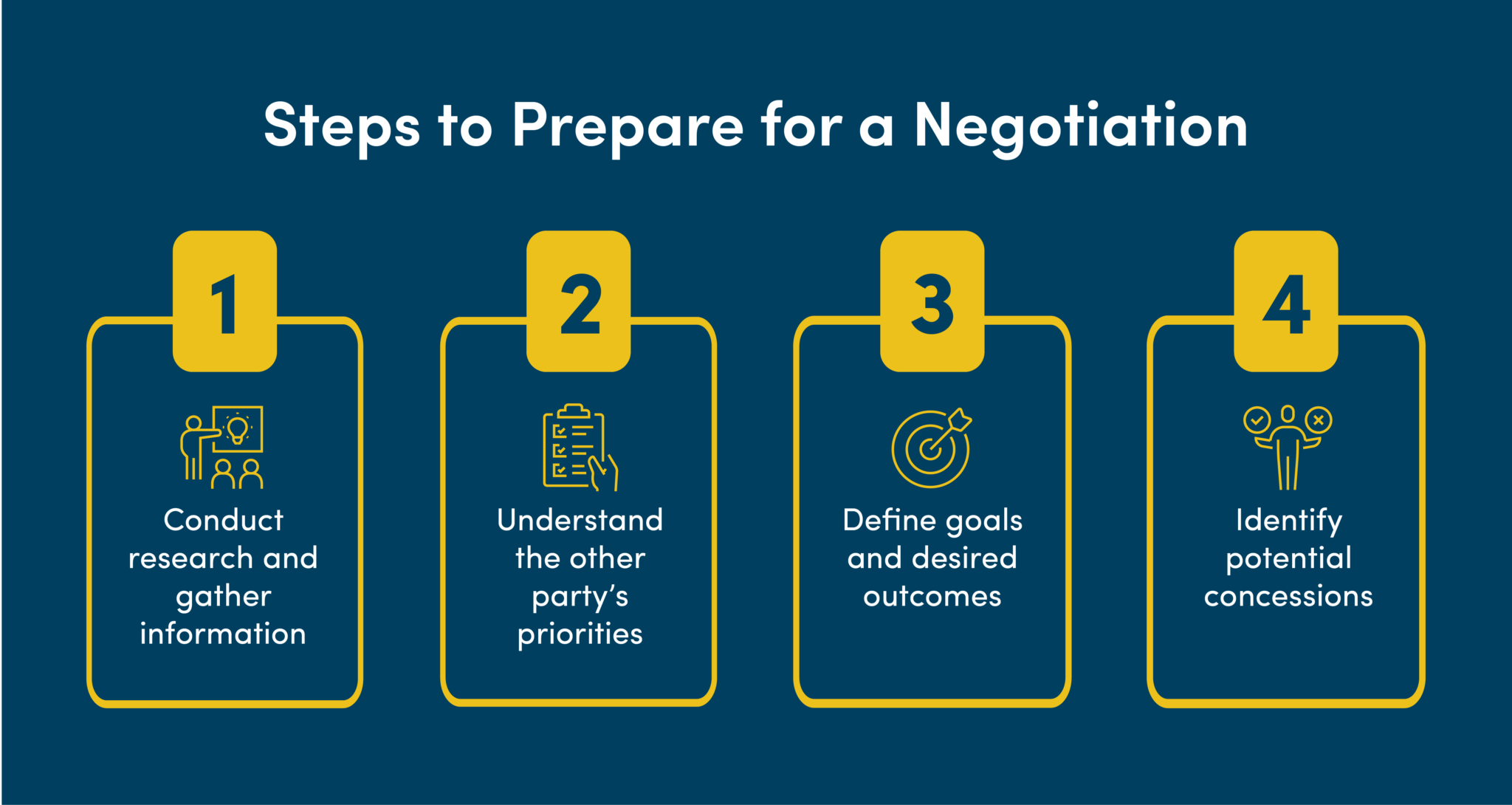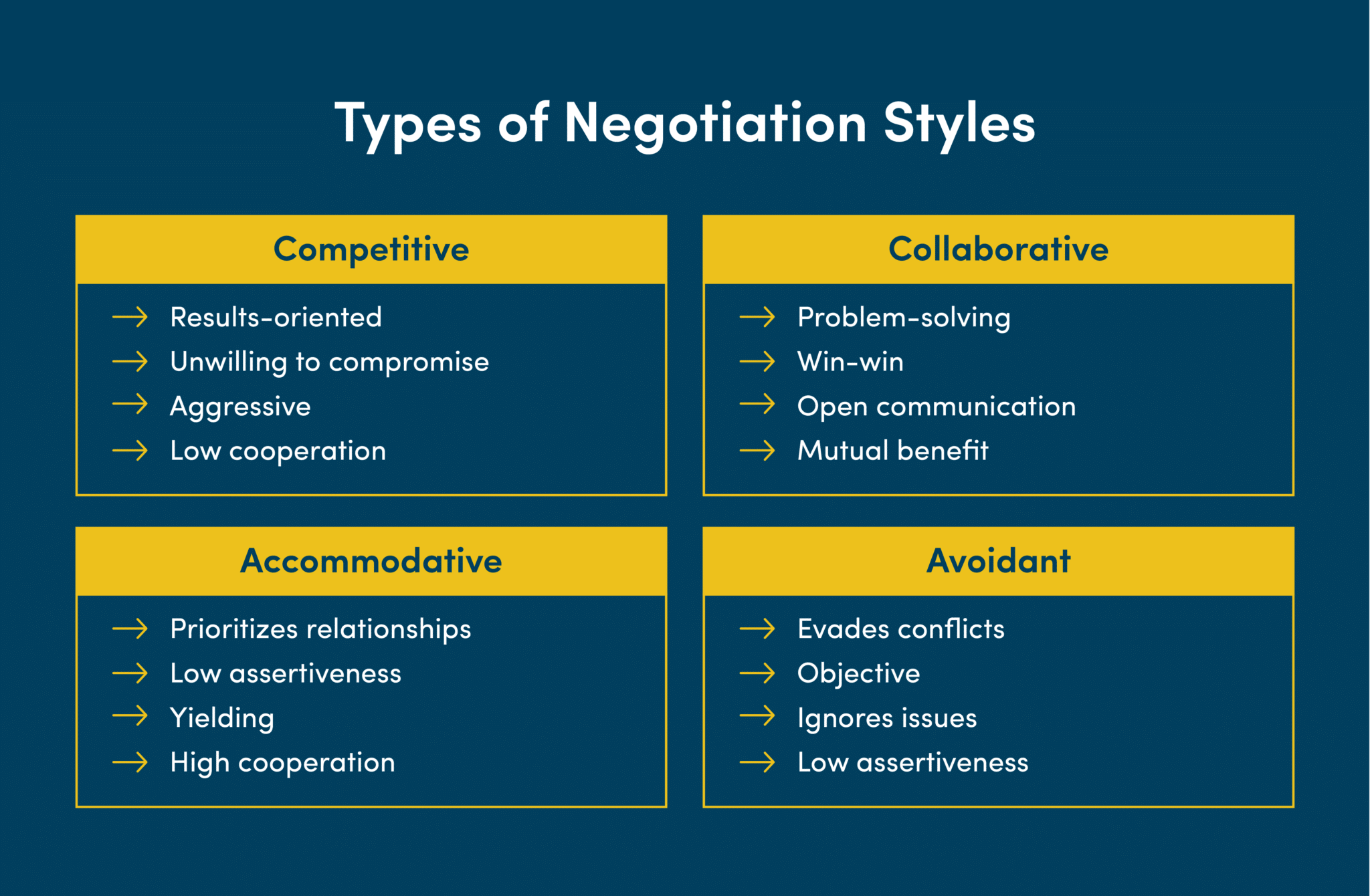What are the best negotiation strategies?

Negotiation is the act of working with one or more stakeholders to find an equitable solution to a situation. The goal of negotiation is to get the best possible advantage while agreeing to concessions that encourage the other party to agree to the terms that have been laid out. There’s an art to successful negotiations, and getting them done requires engaging in good decision-making skills, the ability to listen more than you speak, and using your perception skills to recognize when an offer is good or bad.
In this article, we’ll explore what makes up the best negotiation strategies you can employ during the creation of an agreement of any type. Using these strategies can help you in all facets of your life as well as help you be an effective business leader.
What is negotiation?
Negotiation is a soft skill that is used to achieve a desired outcome between two or more parties. You have a vested interest in getting an outcome that’s favorable for you or your business, and you need to employ negotiation tactics to convince the other party that they should enter into an agreement with you. In the meantime, you need to show the other party that you can be trusted, are interested in listening to their concerns, and crafting a contract or agreement that works in favor of both parties.
Being able to negotiate terms works for everything from getting a better salary to buying real estate and making business decisions. CEOs need to hone their negotiating skills to get the best possible arrangements and terms for a specific goal. That can include getting a lower price on recurring supply orders, encouraging another CEO to partner with your company and create a new product, or negotiating a new office space lease. Negotiation skills are also one of the traits of successful leaders because it shows they can make good decisions on behalf of an organization.
What makes a good negotiation?
It is important to realize that good negotiating skill-building requires compromise. Both you and the other party will have a desired outcome in mind and the ultimate result will likely fall somewhere in between those two objectives. Strive to create a conversation that respectful and courteous to find a resolution that can become a win-win for both.
Why are negotiation tactics important?
Knowing how to leverage negotiation tactics can help in nearly all facets of life. Through negotiation, you’re able to handle conflicts by creating an agreement all parties mutually agree on. As an executive, negotiation tactics are essential and can help your organization in more ways than one. In fact, 90% of business leaders find communication skills, such as negotiation, play a primary role in the future of their businesses. Here are some of the reasons why negotiation tactics are important:

- Growth opportunities: Growth opportunities sometimes involve buying another business, equipment, or supplies. Being able to negotiate a good price helps the business expand while spending less of its capital.
- Crisis management: Negotiations during a time of crisis help a business maintain its normal operating standards while working with other players to find a workable resolution. It also helps those involved keep their cool and act rationally.
- Maximizing value: A good negotiation strategy enables both parties to maximize their value through the acquisition or integration of new sources of revenue that they didn’t own previously.
- Achieving favorable outcomes: The overall goal of a negotiation strategy is to get as close to what you want as possible. This is true even when both parties can’t agree and walk away from the table.
- Enhanced operations: Engaging in negotiation helps a business smooth out rough areas in its operation. All parties involved can use negotiations to find resolutions to their problems through the inclusion of new processes or eliminate ones that aren’t beneficial.
How do you prepare for a negotiation?
Preparing for a negotiation requires engaging in due diligence. That means you need to research the other party to understand them as a whole, identify their priorities, and get an idea of areas where they may concede. Here are the most important elements of preparing your negotiation strategy.

- Conduct research and gather information: Researching the other party’s background helps you understand how it operates, its internal culture, and what affects them the most. This informs you of their strengths and weaknesses, enabling you to take advantage of both aspects during your negotiations. You can better anticipate how they’re going to respond to your proposals.
- Understand the other party’s priorities: The other party in the negotiation also has an interest in coming to an equitable agreement, or else they wouldn’t have engaged in negotiations in the first place. However, their priorities may be different from yours, which is why negotiations are important.
- Define goals and desired outcomes: Defining or setting goals is an important part of your negotiation preparation. Be sure and confident that your stated goals are achievable and well-defined, and be concise. Going into a negotiation without being absolutely sure of what you want can result in you getting less than you’re seeking.
- Identify potential concessions: You need to identify potential concessions you’re willing to give, as they can help close the deal sooner rather than later. Make sure that the concessions you offer are ones that won’t weaken your position or give the appearance that you’re trying to play hardball. This is one of the negotiation tips that can lead to poor results if you’re not careful.
What are effective negotiation strategies?
You can engage in a number of different negotiation strategies that are appropriate for the situation at hand. What sits at the core of all strategies for negotiation is how you handle yourself and your overall view of the situation. The following negotiation tips help you use your emotional intelligence when approaching another party to enter into negotiations.
1. Build rapport and trust
Good negotiating outcomes are a result of good relationships and relationships must be developed over time. Because of that, good negotiators are constantly looking for opportunities to enhance the relationship and strengthen their position. In some cases, the result of the negotiation is determined even before the individuals meet for discussion.
Be as polite and pleasant as you can be when reaching out to another party for negotiations. Both of you are looking to get as much as you can from the process, but you don’t want the other party to feel as if they’re being taken advantage of. You can achieve your goals more easily by being polite, engaging in active listening, and staying flexible.
2. Remain positive
It can be easy to fall into the thinking that you’re not going to get what you want and that the negotiations are a waste of time. Avoid this type of thinking and stay positive while the other party considers your offers. If they say no, you can make a different offer or walk away from the table altogether.
Many negotiators underestimate themselves because they don’t perceive the power they have inside of themselves accurately. In most negotiating situations, you have more power than you think. You must believe that the other party needs what you bring to the table as much as you want the negotiation to be a success. Also, be sure that that positivity is visible during the negotiation. Be aware of the tone of your voice and non-verbal body language while interacting with the other party.
3. Leverage your BATNA
BATNA, or the best alternative to a negotiated agreement, is your backup plan when neither party can come to an agreement. Create your BATNA during your planning phase and have it handy if the other party declines your offer. In some cases, the proposed agreement may be better than your BATNA, requiring you to reconsider your position. However, if the proposed agreement falls short of your BATNA, it may be best to walk away. With a BATNA in place, you can make more informed decisions about whether a deal is worth accepting.
4. Understand all outcomes
As you work on your strategies for negotiation, you need to step back and look at all potential outcomes and what their impact would be. Engaging in this exercise helps you counter or accept the offers made by the other party because you’ve already evaluated their implications and effect on your business.
Don’t be upset if things don’t go your way. In these instances, it’s a good time to reevaluate all positions and return to the table. In most cases, as long as you know the highest and lowest expectations of each party a middle ground can usually be reached in the overlapping areas.
5. Be articulate & build value
This is a key negotiation tactic that separates the good negotiators from the masters. When you have a strong belief in what you’re negotiating for, you will shine. Become a master at presenting your thoughts and ideas so that others see the value.
A tip on how to do that well:
- Be direct when presenting a situation. Be clear about what is expected. Discuss ways to apply how it can happen.
- Don’t simply talk about what needs to happen. Discuss the consequences – how your solution will be beneficial to the other party.
6. Plan concessions strategically
The phrase “don’t put all of your cards on the table” applies to the concessions you’re willing to offer to the other party. In other words, only offer a concession when it’s advantageous to you, and don’t let the other side know about the other items or areas that you’re willing to concede on.
When a person gives something up or concedes on part of a negotiation, always make sure to get something in return as a bargaining strategy. Otherwise, you’re conditioning the other party to ask for more while reducing your position and value. Maintaining a balance will establish that both parties are equal.
Negotiation Tactics FAQs
What are common negotiation styles?
There are different types of negotiation styles you can employ when it comes time to come to an agreement with another party. Below are some of the common types of negotiation styles:

- Competitive: Competitive negotiation consists of getting the most for yourself at the expense of the other party. It’s also known as being aggressive, defensive, or assertive because you have a need to win.
- Collaborative: The collaborative style of negotiation involves creating a pleasant working atmosphere with the other party and keeping each other’s goals in mind. There’s a desire to strike a balance between the two of you and meet each other’s needs in an equitable fashion.
- Accommodative: Accommodative negotiation intentionally puts you at a disadvantage with the other party from the start of the process. You’re not seeking to win so much as you’re looking to make an apology or give a sweetheart deal for a more balanced one in the future.
- Avoidant: The purpose of an avoidant negotiation strategy is to avoid conflict by ignoring the issue at hand. It’s also known as a passive-aggressive style and sometimes happens when the other negotiator is competitive or aggressive.
How do you use anchoring and framing when negotiating?
Anchoring involves stating your initial offer, such as a dollar amount or price, to show what you’re looking for. The first piece of information you provide the other party serves as an anchor that can influence the subsequent negotiation process. Framing is supplying a justification or reason as to why you feel you should be given this amount. Through effective framing, you can emphasize certain aspects while downplaying others to influence how the other party perceives and responds to the information. Together, anchoring and framing can serve as an effective negotiation tactic.
What is a negotiating example in business?
To better understand how negotiation tactics work, let’s explore a hypothetical example. Let’s say you operate a bakery that needs a steady supply of a donut flour mix for your baked goods and at a price point that allows you to return a reliable profit on your donut sales. In order to achieve this, you approach the supplier of the donut flour mix and discuss your need to get a lower price point on the mix. The supplier wants steady business and a long-term partnership while ensuring profits. Through the negotiation process, both the you and the supplier will work together to agree on a price that works for both of them.
Wrapping up: Negotiation strategies
Negotiation strategies help you get what you want from a given situation. It doesn’t matter if you’re the initiator or recipient of an offer to negotiate. What matters is your ability to engage in a negotiation strategy that benefits you, builds your reputation as a reasonable player, and helps you build up your leadership qualities.
These negotiation tips are a starting point for learning how to become an effective business leader. At Vistage, we give you the tools you need to transform yourself into a leader that everyone looks up to and wants to be. Our peer advisory groups consist of experienced executives, business owners, and industry leaders who are ready to share their strategies for negotiation, how to handle the daily operation of an organization, and identify opportunities for growth.
Related Content:
5 Characteristics of an Entrepreneur


Hi Bob, great comments. I especially agree about the practice, great analogy with golf/karate. Are there any specific training exercises you recommend?
well said……:)